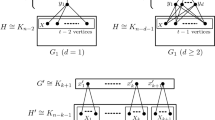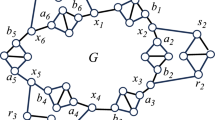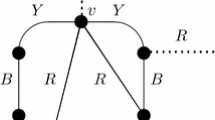For suitable positive integers n and k let m(n, k) denote the maximum number of edges in a graph of order n which has a unique k-factor. In 1964, Hetyei and in 1984, Hendry proved \( m{\left( {n,1} \right)} = \frac{{n^{2} }} {4} \) for even n and \( m{\left( {n,2} \right)} = {\left\lfloor {\frac{{n{\left( {n + 1} \right)}}} {4}} \right\rfloor } \), respectively. Recently, Johann confirmed the following conjectures of Hendry: \( m{\left( {n,k} \right)} = \frac{{nk}} {2} + {\left( {{}^{{n - k}}_{2} } \right)} \) for\( k > \frac{n} {2} \) and kn even and \( m{\left( {n,k} \right)} = \frac{{n^{2} }} {4} + {\left( {k - 1} \right)}\frac{n} {4} \) for n = 2kq, where q is a positive integer. In this paper we prove \( m{\left( {n,k} \right)} = k^{2} + {\left( {{}^{{n - k}}_{2} } \right)} \) for \( \frac{n} {3} \leqslant k < \frac{n} {2} \) and kn even, and we determine m(n, 3).
Similar content being viewed by others
Author information
Authors and Affiliations
Corresponding author
Rights and permissions
About this article
Cite this article
Volkmann, L. The Maximum Size Of Graphs With A Uniquek- Factor. Combinatorica 24, 531–540 (2004). https://doi.org/10.1007/s00493-004-0032-9
Received:
Issue Date:
DOI: https://doi.org/10.1007/s00493-004-0032-9




